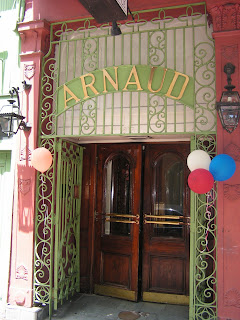 In 1918, a colorful French wine salesman named Arnaud Cazenave opened the grand restaurant that bears his name. Count Arnaud (as he came to be called, without any bona fide claim to the title) practiced a brilliant new approach to the serving of food and drink. He became so influential in his business that it can be said that the entire New Orleans restaurant community reflects, to one degree or another, his ideas. And the style he set inspires everything we do to this day at Arnaud's.
In 1918, a colorful French wine salesman named Arnaud Cazenave opened the grand restaurant that bears his name. Count Arnaud (as he came to be called, without any bona fide claim to the title) practiced a brilliant new approach to the serving of food and drink. He became so influential in his business that it can be said that the entire New Orleans restaurant community reflects, to one degree or another, his ideas. And the style he set inspires everything we do to this day at Arnaud's.Arnaud believed, quite simply, that the pursuit of the pleasures of the table is as worthy as anything else one does in life.For him, a meal that was only a meal was a shamefully wasted opportunity for enhancing one's life. This concept played very well to celebration - minded New Orleans, which took Count Arnaud to its heart instantly.
Located at 813 Bienville St, Arnaud's was the undisputed leading restaurant of New Orleans in the Thirties and Forties. Arnaud's was where one went for any occasion that demanded celebration. It was the prime rendezvous for businessmen from Canal Street, who occupied their regular tables with conversations of great pith and moment over Arnaud's special lunches. The menu created by the Count was vast. Listing (for example) nine oyster appetizers, 51 seafood entrees, and 40 vegetables (among them potatoes prepared 16 ways), it defined French-Creole cuisine for decades. This menu was not just for showing off; the Count chose it to appeal to the entire range of eaters, from the gourmet to the casual diner.
Arnaud's was a very profitable restaurant, and the Count channeled much of its fortune into expansion. He bought up one adjoining property after another until Arnaud's 13 buildings (some of which had previously housed reputed opium dens and houses of prostitution) covered most of the block. He constructed an enormous, well-equipped kitchen - still the largest of any free-standing New Orleans restaurant. He built subsidiary dining rooms throughout the complex, ranging in size from the grand second-floor ballroom with its parquet dance floor to small chambers suitable for sub-rosa assignations. The buzzers used to summon a waiter to the locked rooms are kept in working order. Guests took full advantage of the serpentine network of passageways through the various buildings as a means of maintaining absolute discretion.
 Arnaud's was still in its prime after World War II, when New Orleans became one of the great travel destinations of the Western world. With Europe destroyed and most American cities starkly boring, the excitement and unique culture of the French Quarter drew the most interesting and sophisticated possible travelers. Dinner at Arnaud's was de rigeur.
Arnaud's was still in its prime after World War II, when New Orleans became one of the great travel destinations of the Western world. With Europe destroyed and most American cities starkly boring, the excitement and unique culture of the French Quarter drew the most interesting and sophisticated possible travelers. Dinner at Arnaud's was de rigeur.Just before Count Arnaud died, he let it be known that his successor was not to be the sheltered Lady Irma, but his anything-but-sheltered daughter Germaine. But the Count - and all other observers - doubted her ability to run a restaurant as large and complicated as Arnaud's. But, fueled by a passionate imperative to maintain the reputation of her father's masterpiece, she learned the business inside and out. And, even though her management style was somewhat Byzantine, she ran the restaurant with a strong hand for many years. Germaine had a way of attracting attention, and she adored the spotlight. She defined the restaurant business as theater. "It's a play in two acts," she said, "lunch and dinner."
The choice of Archie Casbarian as the man to keep Arnaud's alive turned on a set of odd coincidences that appealed to Germaine's sense of drama. Archie Casbarian had the same initials as her father.Both men loved good cigars, handsome clothes, fine wines, Cognac and telling an amusing story. Both were born overseas, and both spoke French fluently. They were about the same height. In fact, Germaine thought that Archie looked a lot like her father. As immaterial as those rationales were, they resulted in a decision that could hardly have been better for the future of Arnaud's. In December 1978, Germaine agreed to lease the property and name of Arnaud's Restaurant to Casbarian. On February 28, 1979, the renovated dining room reopened and a long renaissance of Arnaud's began.
